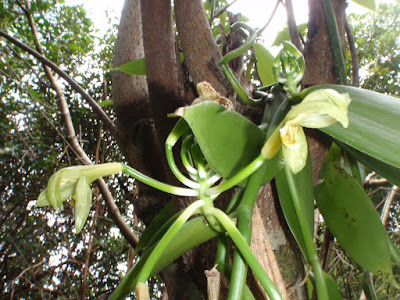Vanilla: travels in search of the Ice Cream Orchid is a book by writer, journalist and broadcaster Tim Ecott that was first published in 2004. It explores the history and current cultivation of vanilla, the world's most versatile flavour, and traces its story from its natural origins on the Gulf Coast of Mexico to Madagascar, Tahiti, Reunion, Seychelles and around the botanical collections of Europe. As someone who lives in Reunion, not far from La Vanilleraie, and who has also translated texts for a vanilla plantation, I was sure the book would interest me.
 |
| cover of Vanilla: Travels in Search of the Ice Cream Orchid |
The book intertwines fact-finding mission, travelogue, natural history and biological detective story. I learnt a number of things about vanilla:
- There are over 25000 species of orchids, and counting. Of all the orchids the vanilla family is the only one that produces an agriculturally valuable crop
- Vanilla is the most labour-intensive agricultural product in the world.
- Unlike other agricultural crops, the amount of vanilla beans available each year is comparatively small - approximately 2000 metric tons.
- More than half the world's vanilla beans end up in the United States. Half of those are used in the dairy industry.
- Under the right conditions, an established vanilla vine is capable of long life in the wild, perhaps 1000 years.
- Vanilla is the only economic area in which Madagascar has an opportunity to influence a world market. The island consistently accounts for half of the world's vanilla production.
The book follows a roughly chronological history of vanilla, starting with four chapters set in Mexico, then after a chapter in the botanical collections of early 19th century England, there are a further four chapters set in Reunion, where he discusses Edmond Albius' contribution to vanilla. I found this especially interesting as although I knew of the 12-year old slave who was the first to discover how to pollinate vanilla flowers had died in poverty, I knew little else about him. After a chapter in Tahiti the final four chapters take place in Madagascar, albeit with most of one of the chapters examining vanilla's importance in the US food industry.
 |
| Edmond Albius (source) |
References are also made to the Comoros (... notorious for its tally of coups d'état and mercenary-led invasions. 19 coups in less than a quarter of a century is still something of a record, I believe), and the Seychelles where the author lived for a time. He explains he chose this latter destination as he had developed an obsession with scuba diving and I enjoyed his remark "underwater I could always escape the claustrophobia of living in a society where everyone knew everyone else's business". He also refers to the south-west Indian Ocean as a region that "other English-speaking journalists didn't bother with [at the time] because they considered it too peripheral to world events. Whenever I made repeated visits to the islands, colleagues would sneer slightly at the idea that I was 'reporting from the beach again'."
 |
| vanilla flower, seen at St-Philippe |
The author knows how to write and makes his subject matter very readable, however I did find some digressions less interesting or wonder whether they weren't just padding. In the penultimate chapter he also makes an amateurish mistake referring to cyclone wind speeds (almost 200 miles an hour) as the speed at which a cyclone (Hudah in this particular instance) was travelling. However all in all, a worthwhile book for anyone with an interest in the subject and destinations discussed.
 |
| Reunion's coat of arms shows a vanilla vine |
Further reading:
- Réunion - In Search of the Ice-Cream Orchid by Michael O'Donnabhain
- Vanilla fever by Wendell Steavenson in The Economist's 1843 magazine (June/July 2019 issue)
 |
| wild vanilla growing at St Philippe |
Related blog posts:
- Grand Hazier & La Vanilleraie - visit of this vanilla production centre which is 2 kilometres as the crow flies from where I live
- Hiking in the shadow of the volcano - a hike near St Philippe which is a prime vanilla-growing area, much also grows wild here.
 |
| wild vanilla growing at St Philippe |
No comments:
Post a Comment